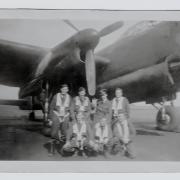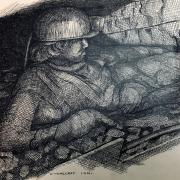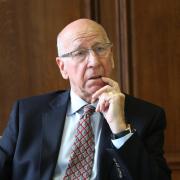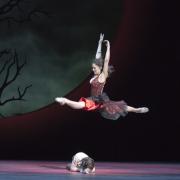This month The Cheshire Yeomanry will parade through Chester, 222 years after their forebears first raised a force to counter the threat of Napoleon/

Bayonets will be fixed, drums beaten, colours flown and three sleek cavalry horses will lead the way as the Cheshire Yeomanry parade through Chester on October 12.
It's a ceremonial show of force the Yeomanry were given the right to exercise when they were granted the Freedom of Chester in 1996. But it is 22 years since they last treated the city to this spectacle.
Despite the noble steeds leading the parade, this cavalry unit has not gone to war on horseback since the Second World War. But it does still hold the distinction of being the last British regiment ever to do so - in the difficult terrain of the Middle East.
The transport of choice these days is the Jackal light armoured vehicle, which will be bringing up the rear of the parade. Though the name, Cheshire Yeomanry, seems arcane and old-fashioned, these reservists couldn't be more relevant in 2019, plugging the gaps at a time when the regular armed forces are spread thin and suffering their share of cuts.

'The reserves are playing a more important role now in the British Army to meet all the commitments we are tasked with in times of economic challenge and lots of demands on government finance,' says Major Stephen Davies, officer in command of the Cheshire Yeomanry.
In the last 15 years, 60 members of Cheshire Yeomanry have served alongside regular Army forces in Bosnia, Kosovo, Iraq, Afghanistan, Cyprus and Poland. Their skills and training are in reconnaissance: stealthy intelligence-gathering and communications.
All of which is a world away from their beginnings in 1797, when landowners and yeomen farmers, fearing a possible invasion by Napoleon, formed a light cavalry unit in Tabley, Knutsford, drawing on the plentiful local supply of horseflesh.
The need to defend Cheshire's green fields against Bonaparte's army never arose. Instead the regiment's first action was at the infamous Peterloo Massacre in 1819. The less-experienced Manchester and Salford Yeomanry had gone in to a crowd of 50,000 gathering in Manchester for a meeting about parliamentary reform, with sabres swinging. Fifteen people died, hundreds were injured, and the Cheshire Yeomanry were sent in to extricate their Manchester counterparts from the melee.

The Yeomanry fought in the Second Boer War, gaining their first battle honours. In the First World War, the Cheshire reservists were in Palestine in 1917, joining the 10th Kings Shropshire Light Infantry, involved in fierce fighting with Turkish forces for Jerusalem, Jericho and Tel Azur, then moving on to France, suffering heavy losses. In the Second World War, the Yeomanry served in Palestine, Syria and Lebanon, and, after giving up their horses in 1942, were given a new role as a Signals unit, then, in 1947, as an armoured regiment.
In 1971, it became C (Cheshire Yeomanry) Squadron of The Queen's Own Yeomanry, an armoured reconnaissance regiment, which served with the British Army of the Rhine until the Berlin Wall fell in 1989.
Today, the Cheshire Yeomanry is 70-strong, including seven women. One such officer is Lieutenant Meg Oakeley, a student at Liverpool University, and a troop leader, commanding a Jackal armoured vehicle. She will be riding one of the horses in the October 12 parade.
'We have people from all different backgrounds,' says Major Davies, who is managing director of Military Wines, which provides wines and wine-tasting events for military organisations.
'Quite a lot are self-employed. We have business people, we have a few members of the police force, some teachers, people working in plumbing, people in banking, in HR, in universities, the full spectrum.'
You can join the Army Reserve (as the former Territorial Army has been known since 2014) from the age of 18 to 50. As a member of the Cheshire Yeomanry, you train every Thursday evening, ten weekends a year, as well as a 15-day annual training exercise, plus parades and community engagement.
If you are sent on active service there are legal protections for your day job. But even in peacetime, part-time soldiering takes up quite a portion of your life.
Employers tend to be understanding about that, says Major Davies, as the Army Reserve promotes the leadership, teamwork and fitness qualities which serve you just as well in your day job.
'It's a life less ordinary,' says Major Davies. 'We're proud of what we do. It's a very tight-knit community, the association is very strong and we look after our own. I'm proud to be part of it.' u
The Cheshire Yeomanry are due to march from Chester Castle at 10.45am on Saturday October 12 to take a salute at Chester Town Hall at around 11.05am, before returning to the castle. A reception will be held later at Chester Town Hall for civic dignitaries and members past and present of the Cheshire Yeomanry.
driving force
Of all those to serve with the Cheshire Yeomanry, few could beat the dash and swagger of Hugh Grosvenor, 2nd Duke of Westminster, who went to war in a Rolls-Royce.
One of the wealthiest men in Britain, the duke was appointed a captain in the then Cheshire (Earl of Chester's) Imperial Yeomanry in 1902, during the Second Boer War.
In the First World War, the duke volunteered for combat and had a hand in the early development of the armoured car in warfare.
Production of armoured vehicles began in the UK in 1914 for dispatch to the war in France. The duke bought his own squadron's cars out of his own deep pockets, and brought his own fortified Mulliner-bodied Rolls-Royce as a command vehicle.
The duke was sent to North Africa, where British forces were fighting not only Turkish forces but also Senussi tribesmen.
The nascent armoured cars operated here in the most inhospitable circumstances. And though the Rolls-Royces were more reliable than other cars in the desert, they also drank fuel at four miles per gallon.
The duke's chance to prove the car's unique worth came when more than 100 British merchant seamen, from two ships torpedoed by German U boats, fell into the hands of the Senussi. The duke's men, in their armoured cars, mounted a daring raid, driving more than 120 miles across pitiless terrain, to surprise the Senussi camp and release the hostages.
'It's one of those situations where someone with the resources, the initiative and the gusto gets stuck in and saves the day,' says Major Stephen Davies.
Or as another veteran of that same war in the desert, Lawrence of Arabia remarked: 'A Rolls in the desert was above rubies'. '
Gerald Grosvenor, the 6th Duke of Westminster - who died in 2016 - also served with the Cheshire Yeomanry, as squadron leader and commanding officer of the Queen's Own Yeomanry. Like his predecessor, the 6th Duke would rally the troops from his specially-adapted Range Rover.



























